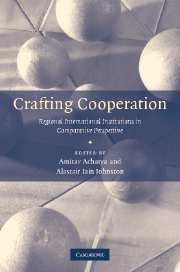Book contents
- Frontmatter
- Contents
- List of tables
- Notes on the contributors
- Acknowledgments
- 1 Comparing regional institutions: an introduction
- 2 Hanging together, institutional design, and cooperation in Southeast Asia: AFTA and the ARF
- 3 International cooperation in Latin America: the design of regional institutions by slow accretion
- 4 Crafting regional cooperation in Africa
- 5 Functional form, identity-driven cooperation: institutional designs and effects in post-Cold War NATO
- 6 Designed to fail or failure of design? The origins and legacy of the Arab League
- 7 Social mechanisms and regional cooperation: are Europe and the EU really all that different?
- 8 Conclusion: institutional features, cooperation effects, and the agenda for further research on comparative regionalism
- Bibliography
- Index
3 - International cooperation in Latin America: the design of regional institutions by slow accretion
Published online by Cambridge University Press: 22 September 2009
- Frontmatter
- Contents
- List of tables
- Notes on the contributors
- Acknowledgments
- 1 Comparing regional institutions: an introduction
- 2 Hanging together, institutional design, and cooperation in Southeast Asia: AFTA and the ARF
- 3 International cooperation in Latin America: the design of regional institutions by slow accretion
- 4 Crafting regional cooperation in Africa
- 5 Functional form, identity-driven cooperation: institutional designs and effects in post-Cold War NATO
- 6 Designed to fail or failure of design? The origins and legacy of the Arab League
- 7 Social mechanisms and regional cooperation: are Europe and the EU really all that different?
- 8 Conclusion: institutional features, cooperation effects, and the agenda for further research on comparative regionalism
- Bibliography
- Index
Summary
The first regional institutions in the Americas emerged in the 1820s as the successor states of Spain's American empire sought to construct stable, amicable, and productive relations between themselves. A relatively thick array of international institutional rules had emerged by the 1930s, well in advance of the foundation of the first formal international regional organizations in the hemisphere and three decades before the establishment of the first successful international subregional institutions. In the international relations of the Americas, the analysis of the emergence of institutional rules must to some extent be decoupled, therefore, from the analysis of organizations.
Yet not until the 1990s did international regional and subregional institutions in the Americas effectively promote trade, defend democracy, coordinate foreign policies, and contribute to an international milieu that reduced the frequency and intensity of militarized interstate disputes over territory and settled many of those disputes. International regional institutions in the Americas did not, therefore, have a crafting moment or a master architect. They resulted from the long accumulation of failures and occasional successes. The analytical task requires explaining the early establishment, long survival, delayed effectiveness, and eventual implementation of the rules of this array of international regional institutions – long periods of stasis followed by change.
In this essay, I argue, first, that the idea of international regionalism was a response to security problems in the immediate aftermath of Spanish American independence in the 1820s. This ideational legacy lingered well beyond the founding cause, however.
- Type
- Chapter
- Information
- Crafting CooperationRegional International Institutions in Comparative Perspective, pp. 83 - 128Publisher: Cambridge University PressPrint publication year: 2007
- 7
- Cited by

